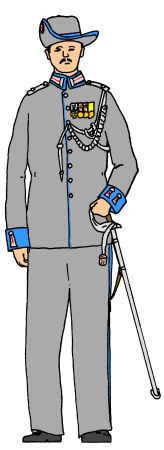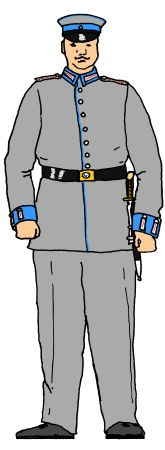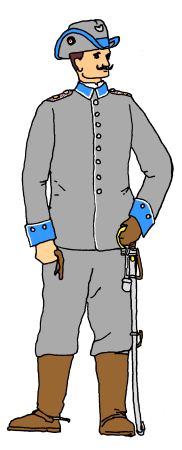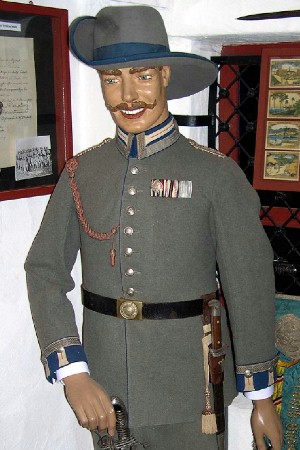|
German South West African Schutztruppe
Home Uniforms 1897-1918 |
 |
 |
 |
 |
|
Figure 1
Officer |
Figure 2
Officer |
Figure 3
Trooper |
Figure 4
Paymaster |
Home Uniforms of the
Schutztruppe 1891-97
Prior to 1896 the Schutztruppe of
South West Africa and East Africa had worn
different uniforms when on leave or home duty in Germany. The German South West
African Schutztruppe had worn Corduroy
Uniforms while the Schutztruppe of German East Africa and Cameroon had worn
Dark Blue Uniforms. On
19th November 1896 a New
Corduroy Uniform (known as the "Kord Waffenrock") was
authorised for the Schutztruppe of all colonies. It was based on the
Prussian Infantry Waffenrock but had a stand and fall collar. White single
Litzen were on the collar and cuffs which were, along with the piping, in
colony colours (blue for South West Africa, white for East Africa and red
for Cameroon).
The 1897 Home Uniform
On 11th March 1897 new uniform regulations were again issued for the
Schutztruppe. The Kord Waffenrock was dropped for East Africa and Cameroon
(I have so far not found any period photographs showing its use by the
Schutztruppe of either colony in this short time), and a new uniform in the same cut but made
from light grey cloth (therefore known as the "Tuchuniform") was
authorised for home wear by the Schutztruppe of all colonies and for the
Schutztruppe of South West Africa on parade in Africa.
It was piped in colony colours,
white for East Africa, blue for South West Africa and red for Cameroon
(yellow for Togo, green for New Guinea and pink for Samoa were
authorised in 1912 but were probably not issued before the First World
War) and had a high stand and fall collar in colony colours with silver
double Litzen lace (white for other ranks) and deep Swedish style cuffs again in
colony colours with silver double Litzen. It had eight white metal
buttons down the front, two on each cuff and three down both of the
scalloped rear pleats also piped in colony colours. It had no exterior
pockets.
On parade all ranks wore aiguillette cords in
imperial colours across the left breast. These were in white cord for other
ranks and metallic lace for officers.
Non-combatant officials such as doctors,
paymasters and gunsmiths wore the same uniform but with distinctive colours for
their arm of service.
Another version of the tunic in the same style
but with no Litzen and the collar and cuffs only piped in the colony
colours rather than filled was known as the "Interimsrock".
Shoulder straps for officers were black/sliver/red braid with
pips (one for Oberleutnant in this case) to display rank in the same way
as the Imperial Army (see Officers Rank
Insignia Page). Other ranks shoulder straps were woven from twisted
cord in black/white/red. NCO rank was displayed in the form of white
metallic lace edging on the collar and cuffs and white metal buttons on
the collar (see
NCO Rank Insignia Page).
The grey trousers (or riding
breeches) were also piped in colony colours. White gloves were
authorised with this uniform.
Headdress
The 1896 Südwester was usually own with the home uniform (see
Südwester Page). It was of grey felt with
a hatband and edging in colony colours. It was held up on the right hand side
with a large imperial cockade.
The field cap was also worn, again in grey cloth
with hatband and piping in colony colours and a small imperial cockade on the
front. It had a black leather peak.
Footwear
In 1896 short brown leather boots were authorised but in 1897 these
were changed to black leather for wear with the home uniform. They were worn with
the trousers loose over the top. Mounted officers and NCOs could wear
brown leather riding boots or short boots with gaiters with the trousers
or riding breeches tucked inside.
Equipment
As the uniform was not intended for use in the field full equipment and marching
order was not usually carried. Usually just a belt and side arm was carried. For
other ranks this consisted of a polished black leather belt with an other ranks
belt buckle (see Belt Buckles). The side
arm was a bayonet (see South West
African Bayonets). Officers worn a belt of white metallic lace with red and
black thread stripes and an officers belt buckle. Officers and senior NCOs
carried the sword.
1916 Field Grey Uniform
On 25th February 1916 new regulations were authorised for the home
uniform worn by the small number of Schutztruppe staff at the Colonial
Office ("Reichskolonialamt") in Berlin. The main changes for the
uniform was that it was now made in the same field grey as Prussian army
uniforms. Aside from that they retained the same cut with colony
coloured cuffs and collar with Litzen. The Südwester hat was officially
replaced by a Prussian army Pickelhaube with an imperial eagle. I have
so far not seen a period photograph of this uniform.
| |
|
|
|
| |
The Illustrations
Figure 1 is based on a photograph of Oberleutnant Kowala of the South West African Schutztruppe.
He wears the 1897 grey home uniform with a Südwester hat. Both have the
blue facing colour of the South West African Schutztruppe. His wears an
officers belt in imperial colours and carries an officers sword.
His medals are the Prussian Order of the
Crown, fourth class with swords, the South West Africa Medal for combatants
with a campaign clasp, the China Campaign for combatants with a campaign
clasp and the Prussian Wilhelm I Centenary Medal.
Oberleutnant Kowala was
commissioned in the 69th Prussian Infantry Regiment. In 1900 he
volunteered for service in China with the 3rd East Asian Infantry
Regiment ("3. Ostasiatisches Infanterie Regt, II. Battalion, 7. Kompanie").
After the Boxer Rebellion he returned to the 69th Infantry Regt until
1905 when he again volunteered for overseas service, this time in the
2nd Machine Gun Unit ("2. Maschienengewehr Abteilung) of the South West
African Schutztruppe during the Herero Rebvellion. In July 1906 he
returned to Germany due to illness, being awarded the Prussian Crown
Order 4. Class with swords upon his return in September. In April 1907
he retired from military service.
Figure 2 is based on a
photograph of an Officer of the South West African Schutztruppe. He
wears the 1897 grey home uniform with a Südwester hat. Both have the
blue facing colour of the South West African Schutztruppe. Note the
scalloped and piped rear skirt of the tunic. He wears an officers belt
in imperial colours and carries an officers sword.
Figure 3 is based on a
photograph of a Trooper of the South West African Schutztruppe. He
wears the 1897 grey home uniform with a grey field cap with hatband and
piping in blue. He wears the polished black leather belt only worn wi8th
the home uniform with an other ranks belt buckle. On his left is a kS98
bayonet with a knot in company colours (see
Bayonet Knots).
Figure 4 is based on a photograph of a South West
African Paymaster. Colonial officials such as paymasters,
veterinarians, doctors etc wore the same home uniforms as the
Schutztruppe but with several notable differences. They did not wear the
Litzen of the Schutztruppe. Their shoulder straps, cap and Südwester
hatbands and piping were determined by their arm of service (in this
case the paymasters blue piped in white). The colour of their buttons
was likewise determined by their arm of service. In this case the figure
wears the blue backing with white piping of a paymaster. Colonial
officials were further distinguished by wearing a small imperial eagle on the
front of their headgear- in this case on the front of the Südwester
slouch hat.
|
|

Schutztruppe NCOs Home Uniform
Photo ©
Traditionsverband
at the Kolonial Museum Linke in Roedelsee |
| |
|
|
|
| |
|
Period Photographs of the South West
African Schutztruppe Home Uniform
|
 |
 |
 |
Unteroffizier Broedertz of the
South West African Schutztruppe
He wears a Schutztruppe 1897
grey home uniform with the Südwester hat. Note the lace
edging the collar and cuffs showing him to be an Unteroffizier. He wears
the other ranks polished black leather belt with an other ranks belt
buckle. Note that like the other two period photographs here, he carries
the authorised white gloves in his hand. This was a popular photographic
pose of the time.
Photo © Peter Klein |
Hauptmann
von Loßnitzer
formerly of the
South West African Schutztruppe
He wears a Schutztruppe 1897
grey home uniform with the Südwester hat. This photograph
was taken in the 1920s. Many former Schutztruppe
personnel continued to
wear their home
uniforms on parade or for special occasions after the
war. His medal bar
shows the Saxon
Knights Cross of St Henry, followed by the Iron Cross second class
(note that as a proud Saxon
wears his Saxon medal ahead of the Prussian one), the Saxe-Ernestine Knights Cross first class with
swords, the Hamburg Hanseatic Cross and another unidentified
medal that may be a semi-official colonial commemorative medal. Below the
medal bar he wears the Prussian Iron Cross, first class
and the post-war Lion Order.
Photo © Christophe Deruelle |
Unknown
NCO of the
South West African Schutztruppe
He wears the 1897 grey home uniform with a marksmanship lanyard
on the left breast and a pe-1913 long service award on the right breast.
Note the lace edging the collar and cuffs showing him to be an
Unteroffizier. He wears the grey field cap with hatband and piping in
blue. He wears the other ranks polished black leather belt with an other
ranks belt buckle at his left side is a kS98 bayonet with a bayonet knot
in imperial colours for NCOs.
Photo ©
Joe Robinson |
| |
|
|
Main Sources
"Bekleidungs-Vorschrift für die
Kaiserlichen Schutztruppen in Afrika" (Uniform
regulations for the Imperial Schutztruppe
in Africa), 19/11/1896, 11/3/1897, 1898 and 29/12/1913. I got my printed copy from Deutsche Kolonien und Militaria on Ebay. Much of it can be
found on the
Traditionsverband Forum.
"The
German Colonial
Troops 1889-1918" by
Jürgen
Kraus and Thomas Müller (Verlag Books)
"Die Deutsche Schutztruppe
1889/1918" by Werner Haupt (Dörfler Publishing)
Photographs from the
Frankfurt University
Colonial Archives and the
Axis History Forum
Please
contact me here if you have more
information or photos on this topic.
Back to
Main Menu for German Colonial Uniforms
|